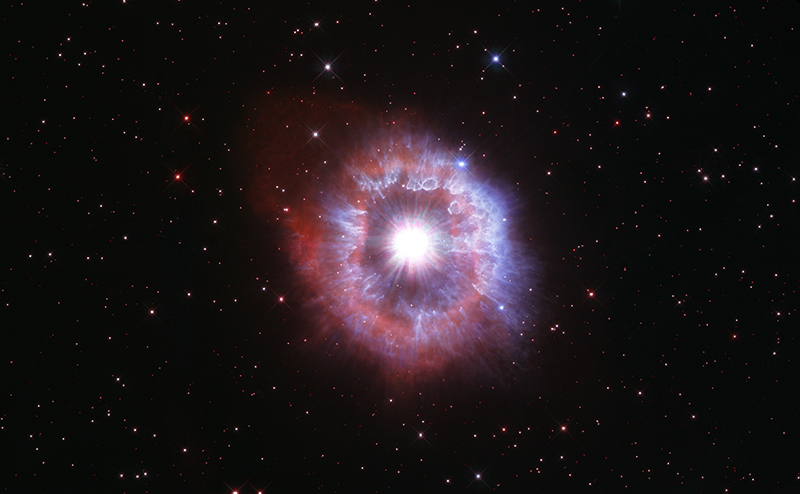DAVID NIELD
27 APRIL 2021
The spectacle of space has our jaws constantly dropping, and the picture that was just released to celebrate 31 years of the Hubble Space Telescope is another incredibly powerful shot that we could gaze at for hours.
It shows the giant, ultra-bright star AG Carinae, 20,000 light-years away from Earth, in a phase that makes it a Luminous Blue Variable (LBV) – where massive stars such as this one go through thousands of years of instability and varying luminosity.
Some 70 times bigger and around 1 million times brighter than our own Sun, AG Carinae is battling itself as it tries to avoid complete annihilation. With gravity pushing inwards and radiation pushing outwards at almost unimaginable levels, the star reaches pressure points where its outer layers blast off in an explosion – as shown in this image.

(NASA, ESA, STScI)
What you can see around AG Carinae is a gigantic nebula, an expanding shell of gas and dust, around five light-years wide – that's the same distance from our planet to Alpha Centauri, our next nearest star, to give you a sense of scale.
This particular eruption happened several thousand years ago. You can see both red material, which is glowing hydrogen gas laced with nitrogen gas, and blue material, which is dust clumps pushed out from the star.
Stellar winds are traveling away from the star at around 1 million kilometers (621,371 miles) per hour, eventually catching up to the circling material and pushing it out into space. To the top left of the photo you can see a more diffuse area of red, where the stellar winds have burst through.
The tadpole-like shapes in blue are clumps of dust that the winds have specifically sculpted. It's thanks to Hubble, and the way it can capture both visible and ultraviolet light from above Earth's atmosphere, that we can see all this in so much detail.
Outbursts like this one will happen a few times during the lifetime of an LBV, and in this case it's estimated that AG Carinae has pushed out a volume of material that's equivalent to 10 times the mass of our Sun.
These spectacular shows happen when a star is about to come apart: by shedding all of these outer layers, the LBV can shrink again and become stable... at least for a while. These stars only live for a few million years (rather than the 10-billion-year lifetime of our Sun).
"I like studying these kinds of stars because I am fascinated by their instability," says astronomer Kerstin Weis, from Ruhr University in Germany. "They are doing something weird."
Happy birthday Hubble, and thanks for all the fantastic images. Since 24 April 1990, the telescope has made over 1.5 million observations of around 48,000 celestial objects.
What you can see around AG Carinae is a gigantic nebula, an expanding shell of gas and dust, around five light-years wide – that's the same distance from our planet to Alpha Centauri, our next nearest star, to give you a sense of scale.
This particular eruption happened several thousand years ago. You can see both red material, which is glowing hydrogen gas laced with nitrogen gas, and blue material, which is dust clumps pushed out from the star.
Stellar winds are traveling away from the star at around 1 million kilometers (621,371 miles) per hour, eventually catching up to the circling material and pushing it out into space. To the top left of the photo you can see a more diffuse area of red, where the stellar winds have burst through.
The tadpole-like shapes in blue are clumps of dust that the winds have specifically sculpted. It's thanks to Hubble, and the way it can capture both visible and ultraviolet light from above Earth's atmosphere, that we can see all this in so much detail.
Outbursts like this one will happen a few times during the lifetime of an LBV, and in this case it's estimated that AG Carinae has pushed out a volume of material that's equivalent to 10 times the mass of our Sun.
These spectacular shows happen when a star is about to come apart: by shedding all of these outer layers, the LBV can shrink again and become stable... at least for a while. These stars only live for a few million years (rather than the 10-billion-year lifetime of our Sun).
"I like studying these kinds of stars because I am fascinated by their instability," says astronomer Kerstin Weis, from Ruhr University in Germany. "They are doing something weird."
Happy birthday Hubble, and thanks for all the fantastic images. Since 24 April 1990, the telescope has made over 1.5 million observations of around 48,000 celestial objects.
No comments:
Post a Comment